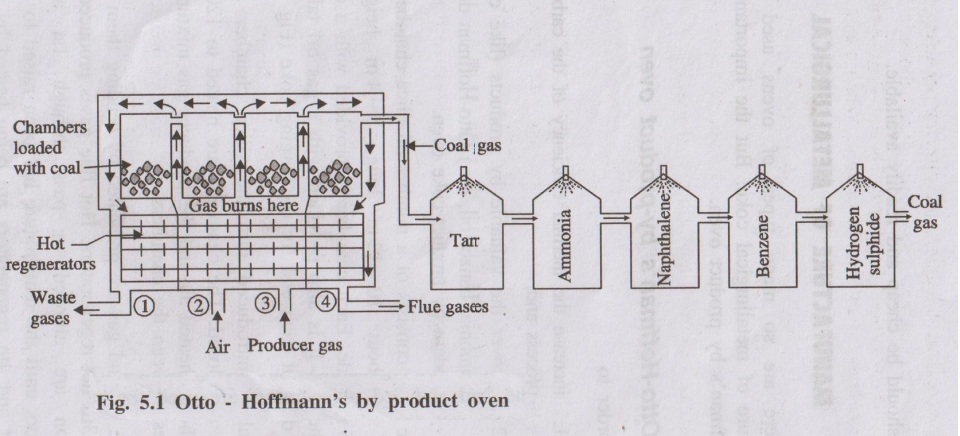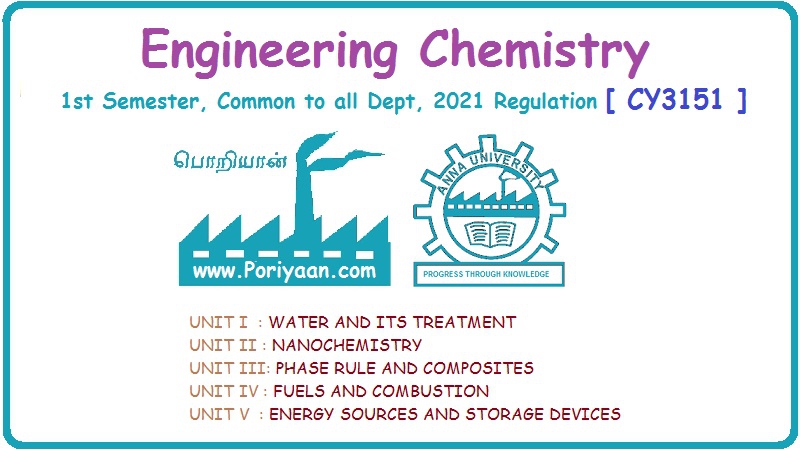Engineering Chemistry: Unit IV: a. Fuels
Manufacture of Metallurgical Coke
Otto-Hoffman's by product oven
There are so many types of ovens used for the manufacture of metallurgical coke. But the important one is Otto-Hoffman's by product oven.
MANUFACTURE OF METALLURGICAL COKE
There are so many types of ovens used for the manufacture of
metallurgical coke. But the important one is Otto-Hoffman's by product oven.
1. Otto-Hoffman's by-product oven
Inorder to
1. increase the thermal efficiency of the carbonization process
and,
2. recover the valuable by products (like coal gas, ammonia,
benzol oil, etc.) Otto-Hoffman developed modern by product coke oven.
The oven consists of a number of silica chambers. Each chamber is
about 10 - 12 m long, 3 – 4 m height and 0.4 – 0.45 m wide. Each chamber is
provided with a charging hole at the top. It is also provided with a gas off
take valve and iron door at each end for discharging coke (Fig 5.1).
Coal is introduced into the silica chamber and the chambers are
closed. The chambers are heated to 1200°C by burning the preheated air and the
producer gas mixture in the interspaces between the chambers.
The air and gas are preheated by sending them through 2nd and 3rd
hot regenerators. Hot flue gases produced during combustion are allowed to pass
through 1st and 4th regenerators until the temperature has been raised to
1000°C. While 1st and 4th regenerators are being heated by hot flue gases, the
2nd and 3rd regenerators are used for heating the incoming air and gas mixture.

For economical heating, the direction of inlet gases and flue
gases are changed frequently. The above system of recycling the flue gases to
produce heat energy is known as regenerative system of heat economy.
When the process is complete, the coke is removed and quenched with water.
Time taken for complete carbonisation is about 12-20 hours. The
yield of coke is about 70%.
The valuable by products like tar, ammonia, H2S and
benzol, etc. can be recovered from coal gas.
Recovery of by-products
1. Tar
The coal gases are first passed through a tower in which liquor
ammonia is sprayed. Tar and dust get dissolved and collected in a tank below,
which is heated by steam coils to recover back the ammonia sprayed.
2. Ammonia
The gases are then passed through another tower in which water is
sprayed. Here ammonia gets converted to NH4OH.
3. Naphthalene
The gases are again passed through a tower, in which cooled water
is sprayed. Here naphthalene gets condensed.
4. Benzene
The gases are passed through another tower, where petroleum is
sprayed. Here benzene gets condensed to liquid.
5. Hydrogen Sulphide
The remaining gases are then passed through a purifier packed with
moist Fe2O3. Here H2S is retained.
The final gas left out is pure coal gas, which is used as a
gaseous fuel.
Advantages of Otto Hoffman's process
1. Valuable by products like ammonia, coal gas, naphthalene etc.,
are recovered.
2. The carbonisation time is less.
3. Heating is done externally by producer gas.
Engineering Chemistry: Unit IV: a. Fuels : Tag: Engineering Chemistry : Otto-Hoffman's by product oven - Manufacture of Metallurgical Coke
Related Topics
Related Subjects
Engineering Chemistry
CY3151 1st Semester | 2021 Regulation | 1st Semester Common to all Dept 2021 Regulation
